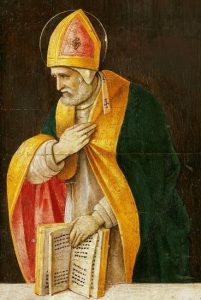 Saint Albinus
Saint Albinus
Bishop (470-550)
Feast – March 1
On the foundation of hard work provided by many saints, among them St. Germanus of Auxerre; St. Eucherius, Bishop of Lugdunum; St. Genevieve; St. Avitus of Vienne; St. Clotilde; and Saint Remigius the Apostle to the Franks, the first daughter of the Church was born. Like every infant needs its mother, and every seedling needs water, the newborn Catholic France needed caretakers. One of those whom God called to perform this work was St. Albinus of Angers.
Born in 470 out of an ancient and noble family in Brittany, the northwesternmost region of France, which was inhabited by people from England and Ireland.
As a young boy, Saint Albinus was drawn into the love and Word of God, becoming fervent in every exercise of piety from early childhood. It wasn’t long before he was seeking happiness in being disengaged from all earthly things and declared to his parents his intention to become a monk. Despite his parents’ disapproval he eventually entered a nearby monastery at Cincillac.
Having embraced the monastic state, he lived as if he had no will of his own, taking upon himself all the humblest offices and disciplining his flesh by every kind of mortification.
St. Albinus lived a quiet life of service, prayer, contemplation, and hard work. He was a perfect model of virtue and a soul governed by the spirit of Christ, living only for Him.
In 504, at the age of thirty-five he was chosen Abbot of the monastery. Saint Fortunatus, his first historian, compared the monastery at that time to a garden rendered beautiful by the most exquisite, most varied, most fragrant flowers.
Twenty-five years later in 529 when Angers needed a bishop, the people turned to the holy Abbot.
As bishop, ablaze with a holy zeal for the honor of God, St. Albinus restored ecclesiastical discipline. He preached every day and took great care of the sick and the poor, for he believed that the soul needs daily nourishment just as does the flesh. He had a special concern for widows who were raising large families. His dignity seemed to make no alteration either in his mortifications, or in the constant piety of his soul.
Many Christians of his diocese had fallen into slavery through the invasions of the barbarians, and Saint Albinus used every resource available to him for their redemption. To add to the graces of charity from which his people benefitted, were those derived from his public miracles.
St. Albinus healed the sick and restored sight to the blind, and was even known to have raised from the dead one boy named Alabald. When one of his servants died during his absence, those who carried the man to his grave were unable to lower him until the bishop arrived to give the final benediction. St. Albinus was so well known for working miracles that faithful people all over Europe, from Spain to Poland, prayed for his intercession.
Those in power sought his counsel and advice, and he found time for everyone—rich and poor, noble or peasant. Honored by all he was never afflicted with vanity. Powerful in works and miracles, he looked upon himself as the most unworthy and most unprofitable among the servants of God. By his courage in maintaining the law of God and the canons of the church, he showed that true greatness of soul is founded in the sincerest humility.
St. Albinus railed against injustice, immorality, and lax behavior on the part of the clergy. He fought for the rights of the poor, and chastised the noble for immoral lifestyles.
Once, the king himself carried off a beautiful young girl and locked her away for his own pleasure. When St. Albinus heard about it, he went directly to the castle and demanded her freedom. The guards dared not oppose him and handed her over. The king did not pursue but had the audacity to demand a ransom for her freedom, which Albinus paid himself.
He restored measures of ecclesiastical discipline, through the third Council of Orleans, convened in 538 through his influence over King Childebert. He procured the thirtieth canon of the council of Epaone to be revived, by which those are declared excommunicated who presume to contract incestuous marriages.
St. Albinus died on March 1, 549 at the age of 80, while visiting those in his community who needed his support, shortly after making a long journey which he undertook to consult St. Cesarius, Bishop of Arles, concerning matters of episcopal government.
His body is interred in the crypt of Saint-Pierre Church at the famous abbey of St. Albinus at Angers, built upon the spot where he was buried by king Childebert. Countless miracles have occurred at his tomb.
References and Excerpts:
[1] E. Staff, “Saint Albinus, Bishop – REGINA Magazine,” Mar. 01, 2017. https://www.reginamag.com/saint-albinus-bishop/ (accessed Feb. 26, 2021).
[2] “Saint Albinus, Bishop.” https://sanctoral.com/en/saints/saint_albinus.html (accessed Feb. 26, 2021).
[3] “ST. ALBINUS, BISHOP OF ANGERS,” Sensus Fidelium, Mar. 01, 2019. https://sensusfidelium.us/the-lives-of-the-fathers-martyrs-and-other-principal-saints/march/st-albinus-bishop-of-angers/ (accessed Feb. 26, 2021).
[4] “Home.” http://faith.nd.edu/s/1210/faith/start.aspx?gid=609&pgid=61 (accessed Feb. 26, 2021).